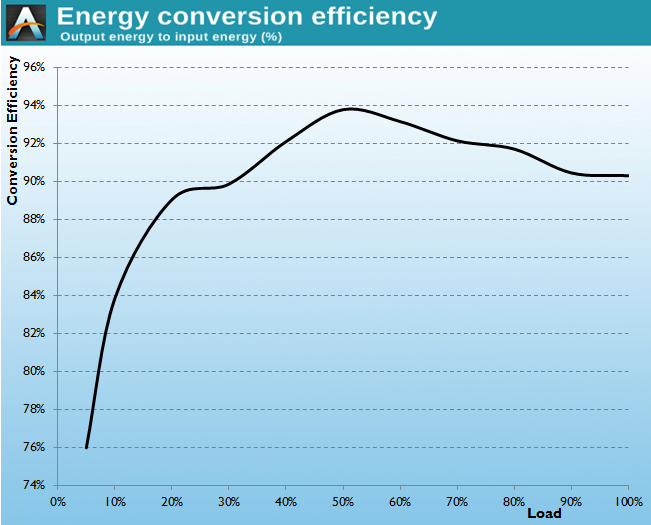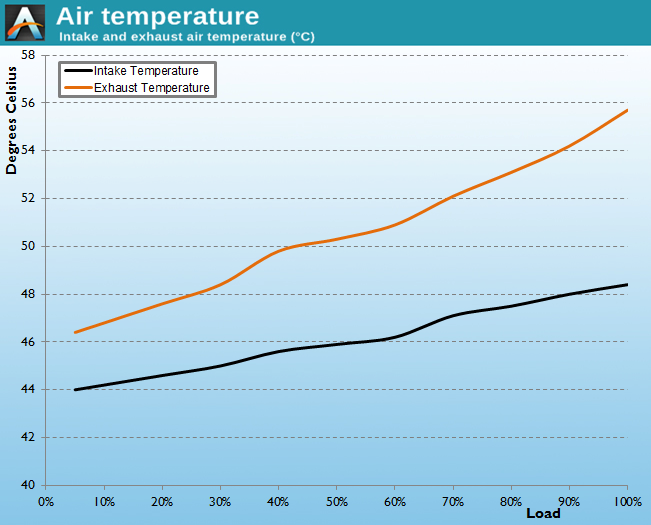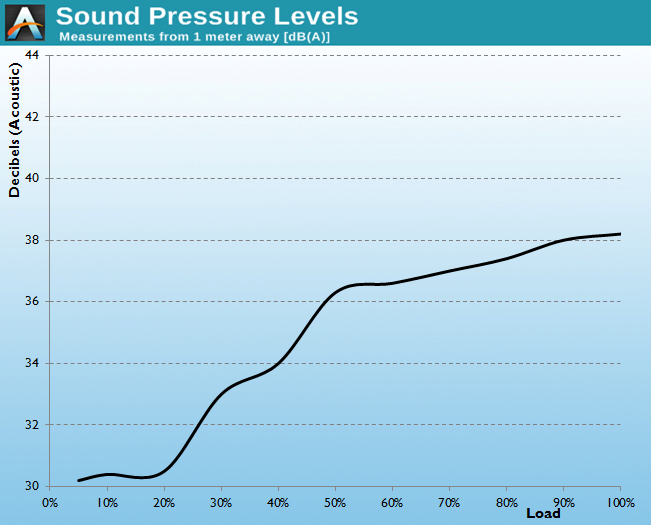Seasonic S12G 650W Power Supply Review
by E. Fylladitakis on February 28, 2014 2:20 PM EST- Posted in
- Cases/Cooling/PSUs
- Seasonic
- 80 Plus Gold
Hot Test Results
From the table below, it can be seen that the output power quality of the Seasonic S12G is very high. The maximum voltage ripple that our instrumentation recorded is a mere third of the ATX design guide suggested limit (the limits are 120 mV on the 12V line, 50 mV on the minor voltage lines), under full load and inside the hotbox no less. Cross-load testing negatively affects the power quality of any power supply but its effect on the Seasonic S12G is small, with the 12V line registering up to 54 mV while delivering 512W. Cross-load testing has virtually no effect on the minor voltage lines, the performance of which did not degrade any further than during standard testing.
| Line |
Regulation (20-100% load) |
Voltage Ripple (mV) | |||||
| 20% Load | 50% Load | 75% Load | 100% Load |
CL1 12V |
CL2 3.3V + 5V |
||
| 3.3V | 2.1% | 6 | 8 | 12 | 14 | 6 | 12 |
| 5V | 2.6% | 8 | 12 | 12 | 16 | 6 | 16 |
| 12V | 1.7% | 14 | 22 | 30 | 46 | 54 | 16 |
The impact that the higher ambient temperature has on the energy conversion efficiency is rather small, reducing the efficiency of the Seasonic S12G by about 0.5% across the entire load range. As such, the Seasonic S12G easily retains its 80 Plus Gold efficiency certification status even inside a very hot environment. The average efficiency between 20% and 100% load is an extremely high 91.6%.
The difference between our cold and hot tests is an increase of over 20°C ambient and, naturally, all of the temperature readings increase significantly. We dare say that the temperatures of the heatsinks rise quite a bit beyond our expectations of an 80 Plus Gold unit by Seasonic; however, the heatsinks are rather small and the design of the power supply apparently focuses on low-noise operation, so sacrifices are made in the area of temperatures.
The low-noise aptitude of the Seasonic S12G becomes apparent when we see that the fan hardly exceeds 38 dB(A) under the harshest of conditions, which is an audible figure but hardly louder than three or four 3.5" mechanical disks -- and never mind the GPUs that would be required to hit such loads. Nevertheless, unless you somehow manage to maintain the unit at maximum load inside a >50 °C environment, the Seasonic S12G will not get nearly hot enough to cause problems.














77 Comments
View All Comments
E.Fyll - Sunday, March 2, 2014 - link
Because an audio recording will be:a) distorted by the sound recording device,
b) distorted by the sound playing device and,
c) entirely unrelated to the original volume.
Even if you consider that a) the recording device is perfect and b) the playback device is perfect, plus d) that the sound file is uncompressed and of very high quality, the end result will be affected simply by how high is the volume knob of each user.
That's misleading, so I'm not going to do it. It has no practical meaning over me simply stating how the unit "sounds like" in the text.
pintos - Sunday, March 2, 2014 - link
How are you measuring the sound level? Wouldn't that have the same problems?pintos - Sunday, March 2, 2014 - link
Also, same question for the rest of your equipment. Don't they also have measuring issues yet they're fine to publish?emn13 - Saturday, March 1, 2014 - link
You're wrong.frequency spectrums aren't hard to read: flat or smooth are plain noise (white or otherwise), and bumpy is tonal. If you include a time component it gets a little messier, but then, we're not talking high-precision sound here, just a general feel of the music; even that may be acceptable.
Furthermore, it certainly doesn't take any high-cost equipment: any bog-standard computer mic will do a surprisingly good job, and if you spend a *little* effort getting a decent (not necessarily best-of-the best) mic and verify the system's quality using a a simple frequency response plot, you can get more than adequate quality for this purpose for at most a few hundred dollars - likely less, but it's not worth your time at that point.
E.Fyll - Sunday, March 2, 2014 - link
Well, frequency spectrums are very hard to read, they do are entirely useless to the standard consumer (the same "type" of noise can actually sound a lot different) and if you think that you can do it with just a "computer mic", well, I have nothing more to say...If I attempt to do anything like that, I would have wasted time and resources on something entirely useless and ridiculously inaccurate. Sorry, that I cannot do. Call me an arrogant perfectionist but I would rather not do something at all if I cannot do it correctly.
quest for silence - Monday, March 3, 2014 - link
"A" in dB(A) stands for "A-weighted"; the further explanation as "the part of dB range that your ears can perceive" is just meaningless.quest for silence - Tuesday, March 4, 2014 - link
"A" in "dB(A)" stands for "A-weighted", so that the subsequent state: «i.e. it is within the part of the dB range that your ears can perceive» is meaningless.g.davis - Saturday, March 1, 2014 - link
Ya, it'd be nice if AT can get numbers for reliability of PSUs somehow. Well, actually, for any electronic device they cover (ie. HDD, SSD, RAM, notebooks, GPU, motherboard, complete systems, etc.). However, I doubt that's possible aside from an occasional external report.Archipelago - Saturday, March 1, 2014 - link
I have had a Seasonic 400W fanless and it's totally quiet. The only time I heard it is the faint click when I shut down.mark28 - Saturday, March 1, 2014 - link
Thanks for the info. This makes me wonder if Seasonic has quality control issues which is far worse than my noise issue. Maybe they just don't test for noise output during quality checks but that kind of ignores a large part of the people who buy fanless parts specifically to reduce noise regardless of efficiency.The noise from the fanless Seasonic PSU I had was so annoying that I replaced it with an actively cooled Corsair one. The difference was like listening to a crying baby and the static noise you hear in between radio stations. Even if it's quieter in volume level (ie. several rooms away), the crying of a baby is way more annoying than static noise.